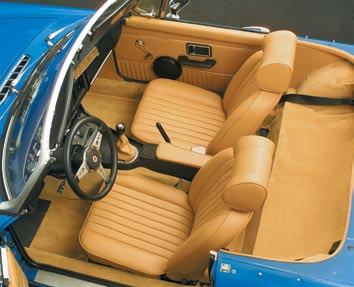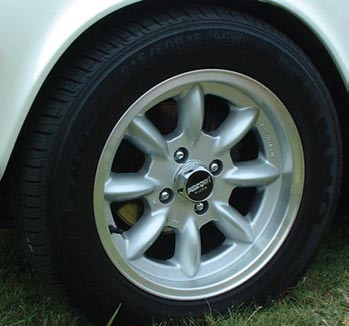Our “better-than-factory” factory
Sometimes you have to take matters into your own hands. When Moss Motors started having trouble sourcing factory-replacement interior parts, we decided to make our own. That was in the seventies. Fast-forward to today, where we manufacture many British sportscar interior panels, upholstery skins, carpets and other non-heat-welded parts to better-than-original specs. Whether you need a seat cover for a 1945 MGTC or one of 650 other upholstery, carpet, top, tonneau, or side cover components, Moss literally has you covered.
Just as modern automotive technology has spawned major mechanical benefits, today’s materials and manufacturing processes are light years ahead of previous generations’. Material quality is superior in many respects, and automation maximizes fit, finish, and overall value.
Heat-seamed interior components became standard in the early seventies, and Moss still sources them from the original manufacturers in the UK. Moss also imports our molded carpet kits. Everything else is “mass-produced” by Moss on a small scale. This allows us to even offer a line of deluxe leather kits for later MGBs that features the same hand-made quality we lavish on our early sewn interior kits.
Upholstery, Seats & Tops
All our leather hides come from Italy. They’re hand-cut, and the surface grain is embossed by our own stamp to replicate the original upholstery’s grain. All vinyl material is sourced from Columbia and is dyed to match our leather.
As new seat frame components have become available in recent years, Moss has been able to add a line of complete seat assemblies. The two main problems used to be finding good frames and competent shops capable of understanding assembly techniques. Of particular note are our MGTF seat assemblies. This type of upholstery fitment was the result of many calls from upholstery shops that weren’t able to properly reskin TF seats.
We also manufacture our own T-Series and MGA tops, tonneaus, and side curtains. Material choices are Haartz Stayfast cloth or vinyl.
Installing seat covers and tops is a skilled job that requires a feel for the materials and an understanding of installation technique. This is why we recommend that all Moss upholstery and tops be installed by a professional. However, with care and dedication the home restorer can produce OE-appearing results.
Interior panels can often be competently installed by weekend do-it-yourselfers. Moss panel kits are assembled on waterproof wood veneer where moisture is a problem. Black waterboard–a resilient, fibrous material–is used where flex is needed such as in door pockets and kickpanels.
Carpet
Early-car carpets were made of wool. When wet, this factory material is prone to mold and mildew. Moss Motors uses USA-sourced polypropylene for our older-car carpet kits. The fibers are specially shaved to give the look and feel of the original wool. For newer cars, our loop carpet materials are sourced from both the UK (molded models) and USA to be as close to the original look as possible. Molded carpets make installation much easier: Flat carpet over rounded profiles such as a transmission tunnels won’t lie flat without making additional cuts and darts. As an alternative, our budget kits for these cars are made in-house from a quality cut-pile using our own patterns.
Manufacturing &Special Orders
Moss’s key to maximizing efficiency and keeping manufacturing costs in check is scheduling. Our special cutting tools rip nine layers of vinyl at a time. These layers can be different colors, so stock hues and special orders are combined until nine of one pattern are needed. This means that less-popular and special-order colors might be held until they can be batched with our standard colors. The upside is that we can offer less popular colors for the same price as the more common black.
Demand for some catalog interior colors is so low that storing items creates color-match problems between panels and seats. These color combinations are made on demand and are handled in the same way as our more popular kits. The bill of materials and construction schedule are added to our batch production; extra kits for stock are often made at the same time.
Special-order non-catalog colors for complete kits present extra challenges. These are handled individually as time allows to ensure that the correct pieces are matched throughout the process. A piping color change is enough to throw off a batch, so time is scheduled each week to handle special-order items. A 15% surcharge is levied due to the extra care required.
Batch scheduling is further complicated by the fact that all leather components are hand-sorted and cut individually to ensure that there are no blemishes or creases. The extra labor and material costs show in the price difference between vinyl and leather kits, but the results are worth it. Visiting the upholstery shop when leather seat kits are being fabricated is a feast for the senses as the colors and scents give a preview of what the proud owner will experience after installation.
Moss Motors’ upholstery shop employs eight skilled craftspeople: two cutters, two panel assemblers, and three sewers. Jenny Winston heads the staff and keeps all the materials on track plus lends a hand at the sewing machine when the end-of-month deadlines approach.
At the end of each work day, we’re proud to manufacture many interior parts for British cars in California. Although the plethora of colors offered in classic British cars is no longer available, we feel that material quality and overall value make every Moss interior component better than new.

Moss Motors has hundreds of factory-spec templates for carpets, interior panels, seat upholstery, and convertible tops.

Assembling upholstery kits requires an extensive inventory of foam, carpet, vinyl, leather, glue, thread, black waterboard, fasteners, and miscellaneous items. Running out of any one item can set production back, so keeping track of supplies and suppliers is extremely important.

This special cutting tool can accurately cut through nine layers of carpet when crafting carpet kits.

Michael shows how carpet pieces are cut and moved in batches of nine. In the background, note how materials are on rollers over the cutting table to maximize speed and minimize lifting.

Here’s a layout for an MGA roadster seat
cushion for both the foam and scrimback,
an intermediate layer that permits the vinyl
and foam to be stitched together.

Once the pattern is marked on the foam, Michael cuts it out with electric shears. Tools like this allow speed and accuracy compared to original manufacturing processes.

These Big Healey rear quarter panels are one of the more intricate components made in the Moss upholstery shop. Here, Sergio applies foam to formed waterboard. The piece will be covered in vinyl later.

Moss sends out vinyl to be made into piping over flexible foam core so that the colors will be an exact match among different lots.
By Kelvin Dodd; photos by Kelvin Dodd










'Inside Moss Motors Upholstery Shop' has 1 comment
April 9, 2018 @ 1:18 pm Norm Thurston
What upholstery glue is used when installing a new foam seat cushion on a new leather seat cover for a 1973 MG Midget? Where is it available?